Press release 2016-02-11 at 16:32
Baltic inflows taken place in the last winter and this winter have improved the oxygen conditions in the near-bottom waters of the Baltic Proper. The area covered by fully anoxic near-bottom water has become smaller. Nevertheless, the oxygen concentration is still critically low in many places, which is expected to prevent benthic fauna from re-colonising the bottoms of the Baltic Proper.
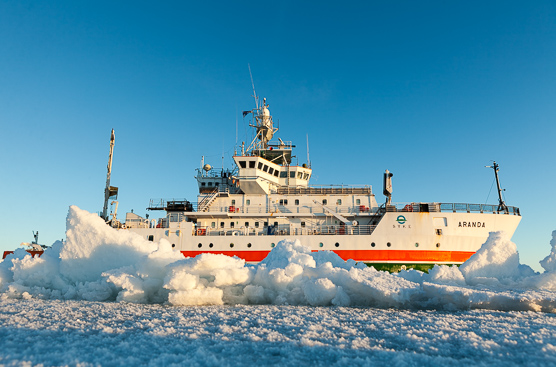
Research vessel Aranda in the Bay of Bothnia 2016. © Ilkka Lastumäki
The Baltic inflow in December 2014 lost its force in the central Baltic Proper in early summer 2015, and it has not moved towards the Gulf of Finland ever since. A new, Baltic inflow, smaller in size, increased the volume of saline, oxygenuous water in the Baltic Proper this winter. The information is based on the results of the monitoring of the Baltic Sea, conducted jointly between the Finnish Environment Institute SYKE and the Swedish Meteorological and Hydrological Institute SMHI on board SYKE’s research vessel Aranda.
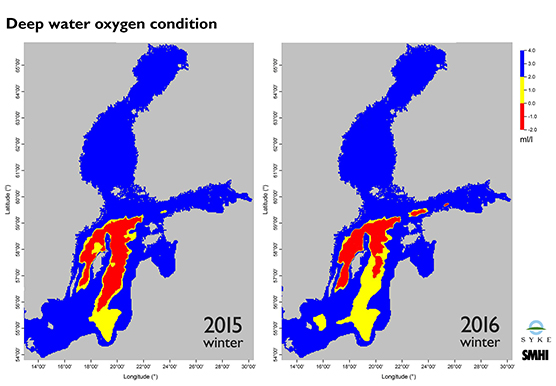
The Baltic inflow in December 2014 slightly restored the oxygen conditions in the Baltic Proper. © SYKE
Western Gulf of Finland is short of breath
The 2014 Baltic inflow pushed the deep water of the Baltic Proper, which is saline, low in oxygen and rich in nutrients, towards the Western part of the Gulf of Finland, where it mixed with the near-bottom water. As a consequence, the near-bottom water in the Western part of the Gulf of Finland has little or no oxygen. Hydrogen sulphide, which is harmful to flora and fauna, was found in the deep near-bottom water in central Gulf of Finland, in an area reaching all the way to Tallinn.
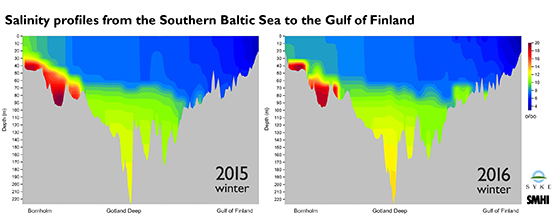
The figure illustrates the inflow of water from the Baltic Proper to the Gulf of Finland. The green area represents the near-bottom water that has spread towards the Gulf of Finland compared to 2015. © SYKE
The phosphorus nutrient content in the western Gulf of Finland is higher than in the previous year. Phosphorus has entered the Gulf of Finland from the Baltic Proper and been released from the sediments due to poor oxygen conditions. In some places, the phosphorus content of the water is the highest observed in decades. However, the more important issue is the nitrogen-phosphorus ratio of the area, which has lowered substantially from 2015. This ratio is reflected in the amount of excess phosphorous.
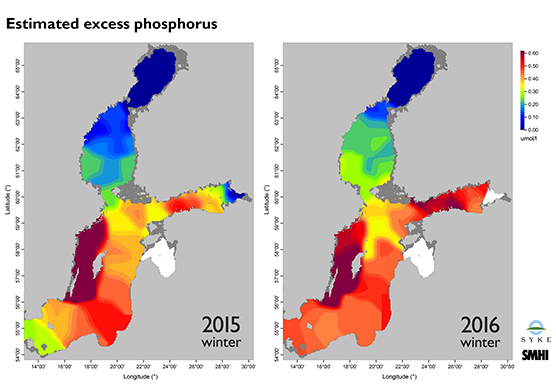
The amount of excess phosphorous was clearly higher in the Gulf of Finland compared to the previous year. © SYKE
After the spring algal bloom, there is more excess phosphorus in the water compared to the previous winter. Excess phosphorus accelerates the growth of blue-green algae in the summer, which means that the current situation could result in even more cyanobacterial blooms in the Gulf of Finland this year. The results from future expeditions on board research vessel Aranda will provide more information on the situation. The weather affects the strength of algal blooms in the summer greatly.
The impact of inflowing waters from the Baltic Proper is smaller on the condition of water near the coast of Finland than on the condition of the western Gulf of Finland. For example, the coastal area near Helsinki is in a relatively good condition, and the condition has changed very little in the past decades.
Few changes in the Gulf of Bothnia
The condition of the Gulf of Bothnia has not changed much in the recent past.. Baltic inflows have no direct effects on the condition of the Gulf of Bothnia, because the ridges at the sea bottom separate the Sea of Åland and the Gulf of Bothnia from the Baltic Proper. The nutrient content has remained mostly unchanged in the Gulf of Bothnia, despite the slight increase in the amount of excess phosphorous. In addition to this, there have been blue-green algal blooms in the Bothnian Sea in summer. However, no major short-term changes are expected to take place in the eutrophication level of the open sea areas in the Gulf of Bothnia.
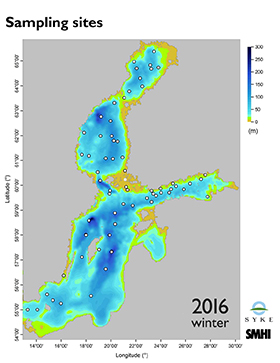
R/V Aranda's sampling sites 2016. © SYKE
More information
Development Manager Juha Flinkman, SYKE Marine Research Centre
firstname.lastname@ymparisto.fi
Tel. +358 295 251 115
Leading Researcher Kaj Myrberg, SYKE Marine Research Centre
firstname.lastname@ymparisto.fi
Tel. +358 295 251 441
Communication Specialist Aira Saloniemi, SYKE
firstname.lastname@ymparisto.fi
Tel. +358 295 251 615
Links of the large picturefiles: